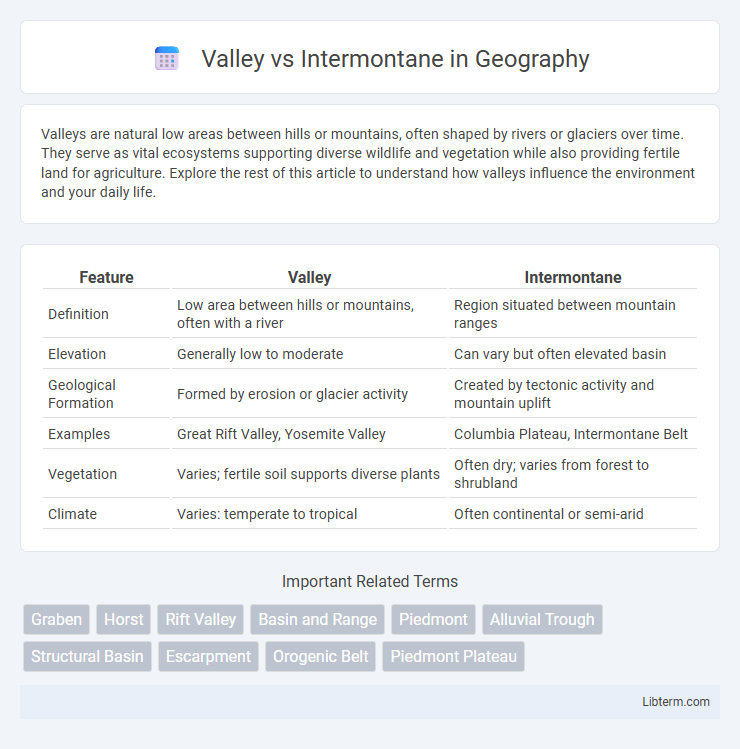Valleys are natural low areas between hills or mountains, often shaped by rivers or glaciers over time. They serve as vital ecosystems supporting diverse wildlife and vegetation while also providing fertile land for agriculture. Explore the rest of this article to understand how valleys influence the environment and your daily life.
Table of Comparison
| Feature | Valley | Intermontane |
|---|---|---|
| Definition | Low area between hills or mountains, often with a river | Region situated between mountain ranges |
| Elevation | Generally low to moderate | Can vary but often elevated basin |
| Geological Formation | Formed by erosion or glacier activity | Created by tectonic activity and mountain uplift |
| Examples | Great Rift Valley, Yosemite Valley | Columbia Plateau, Intermontane Belt |
| Vegetation | Varies; fertile soil supports diverse plants | Often dry; varies from forest to shrubland |
| Climate | Varies: temperate to tropical | Often continental or semi-arid |
Introduction to Valleys and Intermontane Areas
Valleys are elongated low areas between hills or mountains, typically containing a river or stream that shapes their fertile landscapes through erosion and sediment deposition. Intermontane areas refer to regions situated between mountain ranges, often featuring plateaus or basins that experience distinct climatic and ecological conditions due to their elevation and isolation. Understanding these landforms is crucial for studying geomorphology, biodiversity, and the influence of geological processes on regional environments.
Definition of Valley: Key Characteristics
A valley is a low-lying landform situated between hills or mountains, characterized by its elongated shape and often featuring a river or stream flowing through it. Key characteristics include sloping sides, a flat or gently sloping floor, and formation predominantly by erosion or glacial activity. Valleys differ from intermontane basins, as they tend to be narrower and follow the course of water or tectonic activity.
What is an Intermontane Basin?
An intermontane basin is a low-lying area situated between mountain ranges, often formed by tectonic activity or erosion, where sediments accumulate over time. Unlike typical valleys, which are usually carved by rivers or glaciers, intermontane basins are characterized by their enclosed nature, frequently hosting lakes or wetlands due to limited drainage outlets. These basins play a crucial role in regional geology and ecology, acting as sediment traps and distinct habitats within mountainous terrains.
Formation Processes: Valleys vs Intermontane Basins
Valleys form primarily through erosion by rivers or glaciers cutting into the earth's surface, creating elongated depressions with a distinct slope. Intermontane basins develop through tectonic activity, such as crustal subsidence between mountain ranges, resulting in relatively flat, enclosed lowlands surrounded by higher terrain. While valleys are shaped by surface water and ice dynamics, intermontane basins are largely influenced by structural geology and tectonic forces.
Geological Features: Valley vs Intermontane
A valley is a low area between hills or mountains, typically formed by erosion from rivers or glaciers, characterized by its V-shaped or U-shaped cross-section. Intermontane regions are broad, high-altitude plateaus or basins situated between mountain ranges, often filled with sedimentary deposits and featuring complex tectonic activity. Geological features of valleys emphasize erosion and sediment transport, while intermontane areas highlight tectonic uplift and sediment accumulation within enclosed mountain belts.
Examples of Famous Valleys Around the World
The Great Rift Valley in East Africa stretches over 6,000 kilometers and is renowned for its spectacular lakes and diverse wildlife, while the U-shaped Yosemite Valley in California showcases dramatic granite cliffs and waterfalls shaped by glacial activity. The Himalayan Intermontane Valleys, such as the Kathmandu Valley in Nepal, provide fertile grounds nestled between towering mountain ranges, supporting dense populations and rich cultural heritage. In contrast, the Colorado Plateau exemplifies an intermontane region with vast mesas and plateaus surrounded by rugged mountain ranges, highlighting the geological diversity between valleys and intermontane zones.
Notable Intermontane Basins Globally
Intermontane basins, such as the Great Basin in the United States, the Tibetan Plateau basins in Asia, and the Pannonian Basin in Central Europe, are significant geological structures surrounded by mountain ranges that collect sediment and support diverse ecosystems. These basins play crucial roles in groundwater storage, agriculture, and habitation due to their enclosed nature and sedimentary deposits. Unlike valleys, which are typically linear depressions carved by rivers, intermontane basins are larger, often endorheic, and serve as key indicators of tectonic and climatic history.
Ecological Differences: Valley vs Intermontane
Valley ecosystems typically exhibit richer soil fertility and higher moisture levels, supporting diverse plant species and dense forests compared to intermontane regions. Intermontane areas, situated between mountain ranges, often have more extreme temperature fluctuations and drier conditions, leading to sparser vegetation and specialized, drought-resistant flora. These ecological differences influence habitat availability, species distribution, and biodiversity patterns in valley versus intermontane landscapes.
Human Settlements in Valleys and Intermontane Regions
Human settlements in valleys benefit from fertile soils, abundant water sources, and milder climates, making them ideal for agriculture and supporting higher population densities. In contrast, intermontane regions, situated between mountain ranges, often have harsher climates and limited arable land, leading to sparser populations and reliance on pastoralism or trade routes. Valleys typically develop into urban centers due to easier transportation and resource availability, whereas intermontane areas maintain smaller, scattered communities adapted to rugged terrain.
Summary: Comparing Valleys and Intermontane Basins
Valleys are elongated low areas formed primarily by river erosion or glacial activity, often featuring fertile soils and diverse ecosystems. Intermontane basins, by contrast, are large, enclosed depressions situated between mountain ranges, typically characterized by sediment accumulation and distinct climatic conditions. Both landforms serve as critical hydrological and ecological zones but differ significantly in size, formation processes, and environmental dynamics.
Valley Infographic

 libterm.com
libterm.com